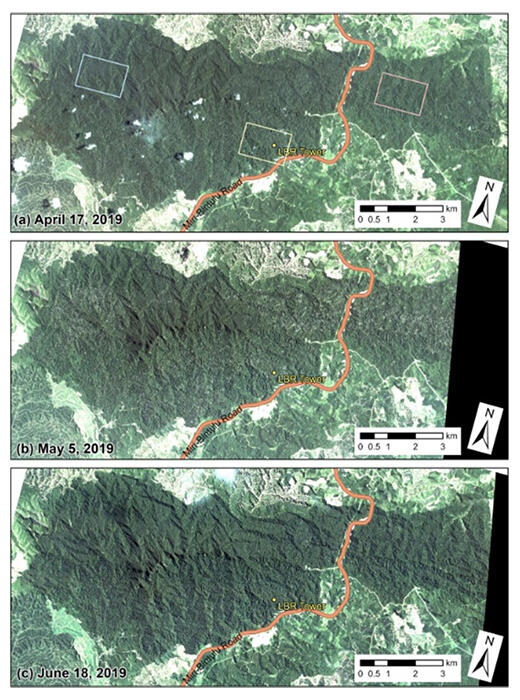An international research team comprising the Japan Agency for Marine‐Earth Science and Technology (JAMSTEC), the University of Hawaii at Manoa (USA), the University of Miyazaki, the University of Zurich (Switzerland), Yokohama City University, the Forest Department Sarawak (Malaysia) and Kochi University, has for the first time in the world captured the "General Flowering (GF)" phenomenon unique to tropical Southeast Asia such as Borneo using spectral data observed by the optical sensors on the high frequency, high resolution PlanetScope satellite.

©Planet Labs Inc. Miura et al. (2023) fig. 4
GF occurred in Lambir Hills National Park (Sarawak, Malaysia) on Borneo between April and May in 2019. The research team documented changes by visual observations from a forest canopy crane and images taken using a time‐lapse camera installed on it. The RGB (red, green and blue bands) composite images observed by the satellite showed points where the color changed from green to white in the forest survey area around the crane. Matching the points of white color change with the location information of individual trees revealed that these were particularly bright‐flowered species, such as Dryobalanops aromatica and Shorea from the Dipterocarpaceae family, and trees from the Anacardiaceae and Tiliaceae families that had flowered. In June of that year, the researchers found a Dipterocarpaceae with a reddish canopy.
A closer examination of the characteristics of the spectral data before and after flowering for the confirmed individuals revealed a statistically significant increase in the simple ratio vegetation index (SR) value, which is calculated from the ratio of visible red bands to near‐infrared bands. This fact showed that color changes in bright canopy colors, such as white and red, can be detected by satellites equipped with optical sensors with a spatial resolution of 3‐4 meters.
Furthermore, when they reviewed the RGB composite images observed by the satellite for the entire park at the same time, they found extensive areas where the tree canopy had turned white, similar to the forest study area around the crane. They found areas of color change in areas of lowland dipterocarp mixed forest, suggesting widespread general flowering of tree species in the vicinity of the crane.
Senior researcher Shin Nagai of the Earth Surface System Research Center, JAMSTEC said, "The GF phenomenon is one of the most important observational items to gain a better understanding of the climate system and biodiversity of the tropical rainforests in Borneo. We expect future developments to include applications to other tropical regions, a deeper understanding of the function of tropical rainforests and the mechanisms of synchrony of flowering seasons between species and more accurate tree species identification."
■ General flowering: The phenomenon of trees of different taxonomic groups in a forest flowering at the same time. The flowering intervals are irregular, ranging from 1‐10 years. It is seen only in the humid tropics of Southeast Asia, including Borneo. Flowering individuals show a white canopy.
Journal Information
Publication: Ecological Research
Title: Utility of commercial high-resolution satellite imagery for monitoring general flowering in Sarawak, Borneo
DOI: 10.1111/1440‐1703.12382
This article has been translated by JST with permission from The Science News Ltd. (https://sci-news.co.jp/). Unauthorized reproduction of the article and photographs is prohibited.




